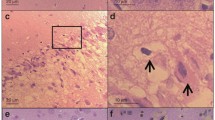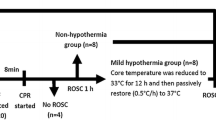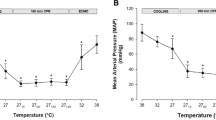Abstract
Objective: There is a remarkable lack of scientific evidence to support the option to use alpha-stat or pH-stat management, as to which is more beneficial to brain protection during deep hypothermic CPB. This study examined cortical blood flow (CBF), cerebral oxygenation, and brain oxygen consumption in relation to deep hypothermic CPB with alpha-stat or pH-stat management. Methods: Twenty-two pigs were cooled with alpha-stat or pH-stat during CPB to 15°C esophageal temperature. CBF and cerebral oxygenation were measured continuously with a laser flowmeter and near-infrared spectroscopy, respectively. Brain oxygen consumption was measured with standard laboratory techniques. Results: During CPB cooling, CBF was significantly decreased, about 52,2%±6.3% (P<0.01 vs 92.6%±6.5% of pH-stat) at 15°C in alpha-stat, whereas there were no significant changes in CBF in pH-stat. While cooling down, brain oxygen extraction (OER) progressively decreased, about 9.5%±0.9% and 10.9%±1.5% at 15°C in alpha-stat and pH-stat, respectively. At 31°C the decreased value in pH-stat was lower than in alpha-stat (29.9%±2.7% vs 22.5%±1.9%;P<0.05). The ratio of CBF/OER were 2.0±0.3 in alpha-stat and pH-stat, respectively; it was kept in constant level in alpha-stat, and significantly increased by 19 °C to 15°C in pH-stat (4.9±0.9 vs 2.3±0.4; P<0.01). In mild hypothermia, cerebral oxyhemoglobin and oxygen saturation in alpha-stat were greater than that in pH-stat (102.5±1.4% vs 99.1%±0.7%; P<0.05). In deep hypothermia, brain oxygen saturation in pH-stat was greater than that in alpha-stat (99.2%±1.0% vs 93.8%±1.0%; P<0.01), and deoxyhemoglobin in pH-stat decreased more greatly than that in alpha-stat (28.7%±6.8% vs 54.1%±4.7%; P<0.05). Conclusions: In mild hypothermic CPB, brain tissue oxygen saturation was greater in alpha-stat than in pH-stat. However, cerebral oxygenation and brain tissue oxygen saturation were better in pH-stat than in alpha-stat during profound hypothermia. PH-stat strategy provided much more oxygen to brain tissue before deep hypothermic circulatory arrest.
Similar content being viewed by others
References
Chan, S., Li, P., 1990. Cytochrome c oxidase: understanding nature’s design of a proton pump. Biochemistry, 29:1–12.
Civalero, L.A., Moreno, J.R., Senning, A., 1962. Temperature conditions and oxygen consumption during deep hypothermia. Acta Chir Scand, 123:179–88.
Dexter, F., Kern, F.H., Hindman, B.J., Greeley, W.J., 1997. The brain uses mostly dissolved oxygen during profoundly hypothermic cardiopulmonary bypass. Ann Thorac Surg, 63:1725–1729.
du Plessis, A.J., Jonas, R.A., Wypij, D., Hickey, P.R., 1997. Perioperative effects of alpha-stat versus pH-stat strategies for deep hypothermic cardiopulmonary bypass in infants. J Thorac Cardiovasc Surg, 114:991–1000.
Gardner, T.J., Horneffer, P.J., Manolio, T.A., Pearson, T.A., Gott, V.L., Baungartner, W.A., Borkon, A.M., Watkins, I. Jr. Reitx, B.A., 1985. Stroke following coronary artery bypas grafting: a ten-year study. Ann Thorac Surg, 40:574–581.
Kadoi, Y., Kawahara, F., Saito, S., Morta, T., Kunimoto, F., Goto, F., Fujita, N., 1999. Effects of hypothermic and normothermic cardiopulmonary bypass on brain oxy genation. Ann Thorac Surg, 68:34–39.
Lassnigg, A., Hiesmayr, M., Keznickl, P., Mullner, T., Ehrlich, M., Grubhofer, G., 1999. Cerebral oxygenation during cardiopulmonary bypass measured by near-infrared spectroscopy: Effects of hemodilution, temperature, and flow. J Cardiothorac Vasc Anesth, 13:544–548.
Mora, C.T., Henson, M.B., Weintraub, W.S., Murkin, J.M., Martin, T.D., Craver, J.M., Gott, J.P., Guyton, R.A., 1996. The effect of temperature management during cardiopulmonary bypass on neurologic and neuropsychological outcomes in patients undergoing coronary revascularization. J Thorac Cardiovac Surg, 112: 514–522.
Priestley, M.A., Golden, J.A., O’Hara, I.B., McCann, J., Kurth, C.D., 2001. Comparison of neurologic outcome after deep hypothermic circulatory arrest with alpha stat and pH stat cardiopulmonary bypass in newborn pigs. J Thorac Cardiovasc Surg, 121:336–43.
Schell, R.M., Kern, F.H., Greeley, W.J., Schulman S.R., Frasco, P.E., Croughwell, N.D., Newman, M., Reves, J.G., 1993. Cerebral blood flow and metabolism during cardiopulmonary bypass. Anesth Analg, 76:849–65.
Undar, A., Eichstaedt, H.C., Fraxier, O.H., Fraser, C.D. Jr., 2000. Monitoring regional cerebral oxygen saturation using near-infrared spectroscopy during pulsatile hypothermic cardiopulmonary bypass in a neonatal piglet model. ASAIO J, 46:103–106.
Author information
Authors and Affiliations
Corresponding author
Rights and permissions
About this article
Cite this article
Li, Zj., Yin, Xm. & Ye, J. Effects of pH management during deep hypothermic bypass on cerebral oxygenation: alpha-stat versus pH-stat. J. Zheijang Univ.-Sci. 5, 1290–1297 (2004). https://doi.org/10.1631/jzus.2004.1290
Received:
Revised:
Published:
Issue Date:
DOI: https://doi.org/10.1631/jzus.2004.1290




